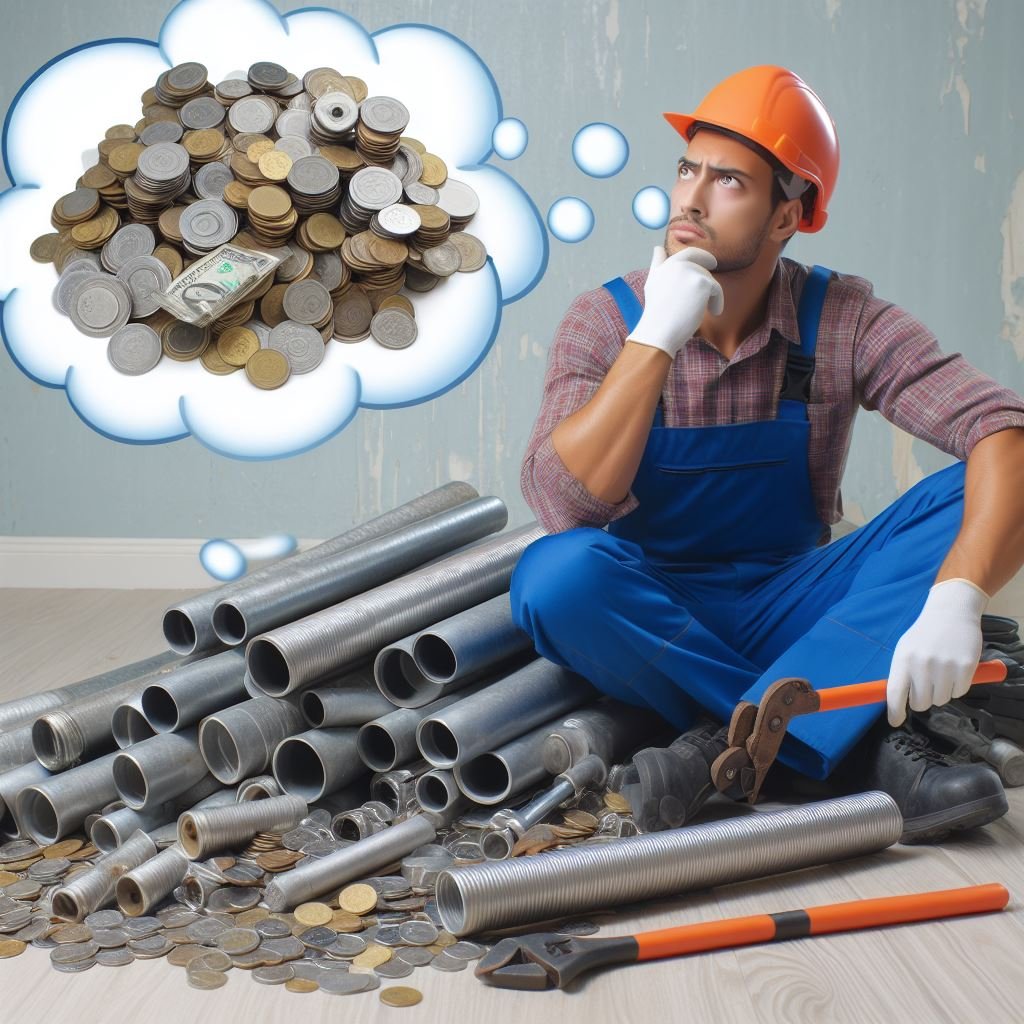The cost to replace galvanized pipes typically ranges from $2,000 to $15,000. Prices vary based on the size of your home and the complexity of the job.
When it comes to maintaining the integrity of your plumbing system in older homes, one crucial investment is replacing galvanized pipes. How much does it cost to replace galvanized pipes, you may wonder? Why aren’t old steel pipes popular anymore? New materials are stronger for homes today.
The cost of replacing these pipes can vary, but it’s a worthwhile expense for ensuring a safe and efficiently functioning plumbing system in your home.
Over time, these pipes can corrode, leading to rust-colored water, reduced water pressure, and leaks. The process involves removing the old piping and installing new copper or PEX pipes, ensuring a longer lifespan and better water quality.

Homeowners should consider the age of their plumbing and watch for signs of corrosion to determine when a replacement is warranted. The cost can be significant, but the benefits of a modern plumbing system justify the investment.
Evaluating The Need For Pipe Replacement
Evaluating the need for pipe replacement in your home begins with an awareness of the issues related to galvanized pipes. As a homeowner, being aware of the condition of your plumbing system is essential.
Galvanized pipes, once a standard, are now outdated and may cause more problems than they solve. This section will guide you through recognizing the telltale signs and Awareness of the impact of corrosion on your plumbing.
Signs Of Galvanized Pipe Failure
The health of your pipes is vital for a safe and functional household. Be on the lookout for:
- Reduced water pressure may indicate a buildup in your pipes.
- Waterspouts that release discolored or rusty water, are often a clear sign of corrosion.
- Frequent leaks could signify the weakening of your pipe walls.
- Pipes that make unusual noises such as creaking or banging.
- Visible rust on the pipe surface.
Impact Of Corrosion On Plumbing

Corrosion substantially weakens pipes, leading to:
- A decreased lifespan of your plumbing system.
- Constant plumbing repairs, which become more frequent over time.
- Potential for severe water damage in the case of a burst pipe.
- Contaminated water supply, which poses health risks.
Addressing these issues promptly can avert costly damages and ensure clean, safe water flows through your taps. Use this information to assess whether your galvanized pipes need replacing and protect your home from unnecessary future expenses.
Types Of Replacement Pipes
When replacing galvanized pipes, homeowners have a choice among different types of pipes. Each option comes with its unique set of pros and cons.
Copper Piping: Pros And Cons
Copper pipes offer long-term reliability, not to mention their resistance to corrosion and high temperature. They’ve been a staple in homes for years due to their durability. Here’s a quick look at their advantages and pitfalls:
- Pros:
- Long lifespan
- Resists corrosion
- Withstands high temperatures
- Cons:
- More expensive compared to others
- Can be difficult to install
Pex Piping: Flexible Solutions
PEX, or cross-linked polyethylene, is a flexible plastic piping that’s perfect for retrofitting in existing homes. Some of the reasons to consider PEX include:
- Pros:
- Highly flexible and easy to install
- Less likely to burst from freezing
- Cost-effective
- Cons:
- Cannot be used outdoors due to UV sensitivity
- May be susceptible to pests
Pvc And Cpvc Piping: Affordable Alternatives
PVC and CPVC pipes are plastic alternatives that provide an affordable option for home plumbing systems. Weigh their pros and cons below:
- Pros:
- Economical choice
- Easy to work with and install
- Does not corrode or degrade over time
- Cons:
- Can crack if water freezes
- Not suitable for high-temperature water
Cost Factors In Pipe Replacement

The cost of replacing galvanized pipes is essential before starting your project. The final price depends on several factors. These factors include the types of materials used, the labor involved, and local regulations. Let’s dip into each of these costs.
Material Costs
The type of pipes you choose has a big impact on the cost. Options range from affordable PEX to pricier copper. Typically, galvanized steel lies in the moderate price range. Remember, prices fluctuate based on market conditions. Check the latest costs for a clear budget.
Labor Expenses
The complexity of replacing pipes can affect labor costs. Factors like the size of your house, the accessibility of pipes, and the time needed for the job play a role. An experienced plumber may charge more, but their expertise can mean a job well done.
Permitting And Regulation Fees
Don’t overlook local building codes and permits. These can influence costs significantly. Every area has different requirements, so checking with your local government is essential. These fees ensure your project complies with safety standards.
| Cost Factor | Details | Estimated Cost |
|---|---|---|
| Material | Type and quality of pipes | Varies |
| Labor | Plumber’s expertise and job complexity | Varies |
| Permitting | Local government rules | Varies |
Consider each of these factors carefully. They ensure a smooth pipe replacement without unexpected expenses. Plan your budget accordingly for a successful project.
Calculating The Total Expense

starting on pipe replacement in your home can be daunting. Understand the costs by delving into the key factors. Calculating the total expense is essential before proceeding. This guide will help you gauge the potential investment.
Estimating Square Footage And Pipe Length
Calculating the required pipe length starts with determining your home’s square footage. The space to cover influences the total cost directly. Here’s how to estimate effectively:
- Measure each room’s length and width
- Multiply to find the square footage
- Sum up the areas of all rooms
Consider all water-using areas, like kitchens and bathrooms. Include exterior spaces if you have outdoor plumbing needs.
The estimated square footage leads to an approximate pipe length. Specialist plumbers can give the most accurate measure.
The Role Of House Size And Layout
The size and design of your property are pivotal in determining the cost. Larger homes with complex layouts often require more materials and labor. Here’s what to keep in mind:
- Number of stories: Multiple levels may need additional piping.
- Number of bathrooms: More fixtures increase total length.
- Types of walls: Difficulty in accessing pipes can influence labor pricing.
| Home Size | Estimated Pipe Length | Cost Range |
|---|---|---|
| Small (up to 1,500 sq ft) | Varies | $2,000 – $5,000 |
| Medium (up to 2,500 sq ft) | Varies | $4,000 – $10,000 |
| Large (3,000+ sq ft) | Varies | $8,000 – $15,000+ |
Remember these numbers are rough estimates. Consult a local plumber for precise figures. They will account for all nuances in your home structure.
Saving Money On Pipe Replacement

Replacing galvanized pipes in your home can be a major expense, but there are ways to save money without compromising on quality. The costs and options for pipe replacement will help you make informed decisions that can lead to significant savings.
Diy Considerations: Is It Worth It?
starting on a do-it-yourself pipe replacement project could cut costs. But it’s vital to weigh the pros and cons.
- Tools and Equipment: You’ll need the proper tools, which could be expensive.
- Skills: Ask yourself if you have the plumbing skills needed for a successful replacement.
- Safety: Understand the safety risks involved in plumbing work.
- Time: Consider if you have enough time to complete the job properly.
Getting it wrong can lead to more costs down the line. Make sure you’re fully prepared before tackling a DIY pipe replacement.
Hiring A Professional: Long-term Savings
While hiring a professional may seem costly, it can be an investment that offers long-term savings.
- Quality Workmanship: A professional plumber ensures a job well done, which means fewer issues in the future.
- Warranty: Many plumbers offer a warranty on their work, providing peace of mind and potential savings on future repairs.
- Efficiency: Professionals can complete the job faster, which minimizes the disruption to your home.
- Up-to-date Knowledge: Experts are aware of the latest plumbing technologies and can offer solutions that are more efficient and effective.
Consider the long-term benefits and potential risks before deciding to hire a professional for pipe replacement.
Final Thoughts Before Re-piping
Replacing galvanized pipes in your home is a major project. It can improve water quality and prevent leaks. Before you dip into re-piping, think about these vital details. Remember, smart choices now mean fewer headaches later.
Choosing Quality Materials
The material choice affects cost and durability. Options vary from copper to newer plastics like PEX. Consider the longevity and performance of materials. For instance, copper is durable but pricey. PEX is cost-effective and easy to install. Weigh these factors:
- Corrosion resistance – Ensures long-lasting pipes.
- Water quality – Some materials may affect taste or health.
- Flexibility of installation – This could lower overall costs.
Selecting A Reliable Plumbing Contractor
Installation quality matters as much as pipe material. Here’s how to find a trustworthy plumber:
- Check credentials – License and insurance are musts.
- Read reviews – Look for consistent positive feedback.
- Ask for references – Contact past customers.
- Get written estimates – Helps avoid unexpected costs.
Choose experience over low cost. A skilled contractor may charge more but can save money in the long run with quality work.
Frequently Asked Questions On How Much Does It Cost To Replace Galvanized Pipes
What Is The Average Cost For Replacing Galvanized Pipes?
The average cost to replace galvanized pipes usually ranges from $4,000 to $15,000. This varies based on factors such as house size, pipe location, and labor charges.
How Long Does Galvanized Pipe Replacement Take?
Galvanized pipe replacement in a residential setting typically takes 2 to 7 days. The duration depends on the complexity of the plumbing system and accessibility.
Are Galvanized Pipes Worth Replacing?
Yes, replacing galvanized pipes is often worth it. They can corrode over time, leading to leaks, water damage, and health hazards from rust-contaminated water.
Can I Replace Galvanized Pipes Myself?
DIY replacement of galvanized pipes is possible but not recommended. It requires skill, proper tools, and an Awareness of building codes. Professional plumbing is safer and ensures quality work.
Is it worth it to replace galvanized pipes?
Yes, replacing galvanized pipes is often worth it as they can corrode over time, leading to water quality issues and potential plumbing problems. Upgrading to more modern and durable piping materials can enhance the longevity and efficiency of your plumbing system.
How many years do galvanized pipes last?
Conclusion
The costs involved in replacing galvanized pipes are vital for any homeowner. Prices can vary widely based on factors like home size and pipe location. To avoid surprise expenses, always seek multiple quotes and consider long-term benefits when choosing materials.
Remember, investing in your home’s plumbing ensures safety and increases property value.


